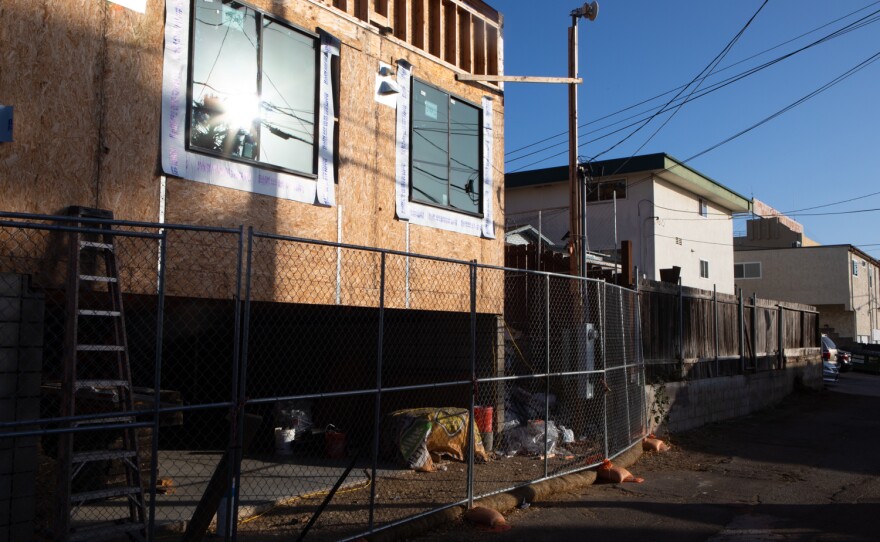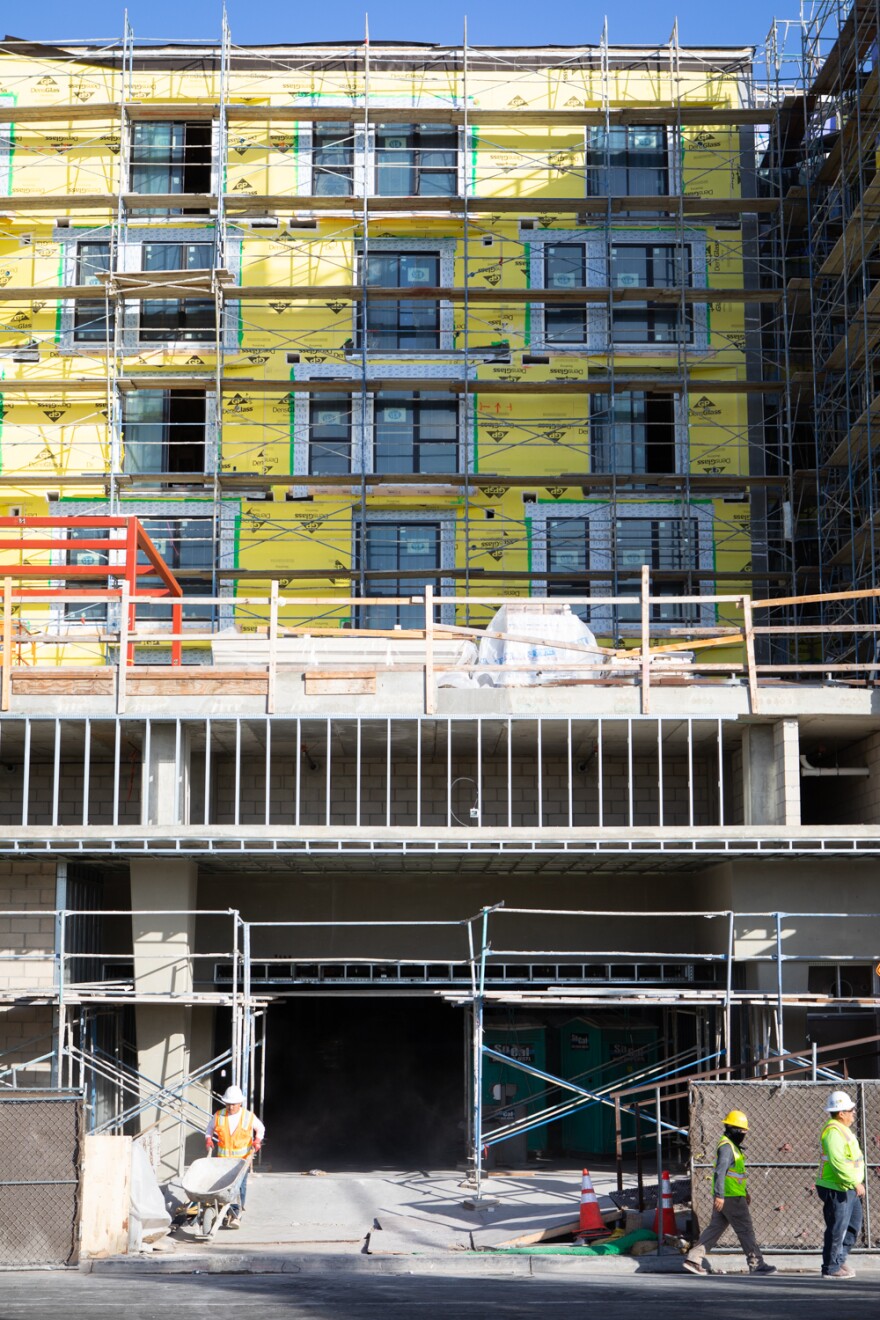San Diego’s building department is overwhelmed by permit applications and grossly understaffed to meet demand, using antiquated technology and redundant processes to authorize new housing.
Those are among the findings of a 22-page report that attempts to answer why the city is so “woefully off pace” from meeting housing production goals.
A regional housing study projected San Diego will need more than 13,500 housing units every year to meet the demand of all income levels by the end of the decade. This year, the city only authorized construction on a third of that.
Three industry experts told inewsource it can take San Diego’s Development Services Department anywhere from five months to a year to issue relatively straightforward housing permits — delays that cost hundreds of thousands of dollars. By the time the city gives the green light to build, inflation has driven up the price of labor and supplies.
“With interest rates the way they are, it could make a project completely out of the realm of possibilities,” said Jared Basler, a San Diego native who has been designing and permitting small housing throughout California for the last 10 years.
“It can be the difference between a housing unit getting built or not.”
Released last month, the report details a number of barriers to home construction in San Diego and includes policy recommendations to remove them. Among the recommendations are:
- Stop duplicating efforts to finance affordable housing.
- Make it easier to build prefabricated housing.
- Find ways around height limits to allow for more development.
It included challenges facing the city’s planning and economic development departments, as well as the San Diego Housing Commission. But the city’s “one-stop shop” for building permits, development services, presented multiple hurdles to new housing. The report recommended technology upgrades and a complete redesign of the permitting process to improve efficiency.
Elyse Lowe, director of development services, told inewsource she felt the report was mostly fair, but it was a good opportunity for the city council to see what she and her staff are up against — close to 100 vacancies in a department that receives 60,000 permit applications a year.
“This is a very arduous, labor-intensive process,” Lowe said. “I wish it were quick and dirty, but the regulations are complex and they continue to become more complex every year.”
The department has already started trying to streamline and simplify the permitting process for both staff and applicants, she said, and officials hope to fill 44 new positions dedicated to housing permits by January.
“We hear stories from developers and homeowners everyday about issues with the permitting process,” City Council President Sean Elo-Rivera said in a statement. “In the worst cases, we could be needlessly delaying the creation of affordable homes for a city and region that desperately need them.”
Elo-Rivera, along with council members Stephen Whitburn and Vivian Moreno, requested the analysis back in August to understand what is holding the city back.
Whitburn told inewsource in a statement there is wide agreement that the city’s building department is overworked and understaffed, and he looks forward to filling those new positions.
“Once those new personnel are up to speed in the coming year, we should evaluate the impact on permit processing times and determine what additional steps may be warranted,” Whitburn said.
Moreno’s spokesperson said the councilmember is too busy to talk about the lack of housing, one of the most important issues facing San Diego.
This report comes in the midst of a worsening housing crisis in San Diego. Half of the city’s housing supply are rental units and less than 1% are vacant, records show. The lack of supply has driven up rents by 15% compared to last year, according to a study from the Southern California Rental Housing Association.
“It’s basic economics,” said Al Abdallah, chief operating officer at the Urban League of San Diego County. It’s a nonprofit advocacy group that focuses on housing.
“Until we build more supply, this is not going to get any better,” Abdallah said. “We don’t have enough new development to keep pace with demand.”

‘Sheer volume and complexity’
One big challenge facing San Diego when it comes to building new housing is a lack of vacant land, the report said. Much of the city is already built out, so that leaves infill — or building in underused property within existing development. But that comes with regulations.
“We have different sets of regulations in the city at any one point in time,” said Gary Geiler, deputy director of development services. “There might be four different versions of a regulation that a designer has to design to, or staff has to review against.”
The building department is responsible for enforcing all of the city’s rules and regulations, as well as those from many other agencies, including school districts, the state, federal wildlife agencies and the U.S. Army Corps of Engineers.
“The sheer volume and complexity of regulations governing housing permits constrain how fast (development services) can complete its review and issue permits in compliance with regulatory requirements,” the budget analyst’s report said.
Depending on the size of the project, anywhere from one to 50 employees could be involved with a single permit application. But the department is working through severe staffing challenges.
Nearly a third of the positions that deal with permit applications are unfilled, close to half of the department’s staff have fewer than five years’ experience with the city, and one out of every five employees are at or near retirement, the report said.
“When I started in 2014, pretty much everybody here had about 25 years’ experience. Those days are gone,” said Lowe, the department’s director. “It is a complicated business and it takes years to really become an expert in the regulations, and that actually does affect our processing time.”
Hiring and training has ramped up, Lowe said, with the department adding 100 new hires over the past year. But the department lost roughly 70 people during the same period.
At any rate, the workload is only getting heavier. Records show staff is seeing a 10% increase in applications every year — up from 59,000 in 2020 to 68,000 this year.
The city council set aside money to fill 80 positions in the building department this fiscal year. Of the 44 new hires dedicated to housing permits starting in January, 30 of them will be focused on reviewing applications, a spokesperson said.
Even so, they don’t have the tools to most efficiently review these applications, according to the budget analyst’s report.
The department’s project tracking system, known as Accela, is seven years old and may no longer meet the demand. In addition, San Diego is the only large city in the state that uses online PDF documents to manage its municipal code. That means staff has to search through one PDF after another to track changes to these complex housing regulations. Every other large city uses “code libraries” that allow for quick searching and cross-referencing all in one place.
The building department also has over 750 application forms to fill out, some of which are outdated and duplicative, and 1,000 different fees. All of it slows the process down.
Staff has already started trying to reduce the number of forms, and hired a consultant to conduct a study and cut down on the fee types. That study should be ready for the city council early next year, Lowe said. Officials have also started the process of soliciting bids to replace Accela, and they hope a grant will cover the cost of a new code library.
Still, the report recommended a comprehensive overhaul of the permitting process to reduce administrative burdens and improve efficiency. Council President Elo-Rivera told inewsource he will work with Mayor Todd Gloria and building department staff to see how the city council could be most helpful.
The only disagreement Lowe had with the report was the notion of redundancy. She said she didn’t find any evidence of that.
“Redundant means you do the same thing over and over,” she said, adding that applicants don’t always comply with requests and it drags the process out when the project keeps returning to staff incomplete.
“We’re not going to issue the permit until everything’s checked off,” Lowe added.
‘That’s a bad sign’
Permit applications can range from installing a water heater to building a high-rise. And there are generally two kinds of permits: ministerial, the run-of-the-mill projects that must be approved as long as they meet the standards, and discretionary, the projects that require analysis and deliberation.

The report said it takes the building department two months, or 55 days, to issue ministerial permits, while discretionary permits take just under a year, or 330 days. But department officials said those averages don’t show the full picture, and they provided records that indicate just over half of all applicants receive their permits in the same week.
“If a designer comes in, knows the rules and the reviewer identifies what they need to do, it can be done quickly,” said Geiler, the deputy director.
Whitney Hill has had a different experience. She’s the co-founder of an Oceanside-based company that designs and builds accessory dwelling units, also called granny flats. The city for years has tried to encourage adding small units such as these to single-family properties in a push to increase the affordable housing stock, and Hill said her company has 20 projects in San Diego either working their way through permitting or in active construction.
In many ways, Hill said, San Diego is leading the pack when it comes to developing granny flats.
“Things that other cities are saying ‘No’ to, they’re saying ‘Yes’ to,” she said, such as building as many units that can fit in a single lot.
These granny flat projects are considered ministerial, lumped in with other small projects that can be issued a permit quickly. But, in her experience, rather than receiving a permit the same week, or even two months, Hill presented data that shows her projects in San Diego are spending roughly five months with the building department.
By the time her company is ready to build, inflation has driven up the cost 20%, she said.
“That’s massive, tens of thousands of dollars on these projects,” Hill added. “For some people, it just makes it a deal breaker.”
To maintain her clients, she’s had to make a business decision and lock in prices for six months.
It hasn’t always been this way, said Luke Woolsey, owner of an El Cajon-based construction company, who has obtained more than 100 housing permits from San Diego over his 24-year career. He said the expectation for a long time was two to four months to receive a permit.
But the pandemic brought increased demand and a staffing shortage throughout the industry.
“Now, when we’re looking at projects, it’s like, yep, that one’s been a year, that one’s been 14 months, oh look, this one came up quick, it’s been 10. That’s a bad sign,” he said.
“I’m seeing clients get to the finish line of the permit process and say, ‘I can no longer afford to do my project.’”
And for many, these permits can’t come soon enough. Woolsey said he’s had clients who lost income and were forced to downgrade to a granny flat and either rent out the primary home on the property or combine households. Another lost their home to a fire. But there’s no channel to speed up permits for these situations.
“A lot of clients here are in need,” Woolsey said, “and if we don’t figure out a way to kind of make this a uniform, streamlined process, I think we’re going to continue to fall further behind.”








